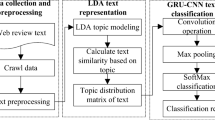Abstract
With the advanced tendency of big data, there are billions of text messages posted on the Internet to express peoples’ views and opinions all the time. And with the explosive growth of text information flow in social network, the topic detection and the sentiment analysis have become important researches in the field of NLP (natural language processing). There are two ways to analyze the sentiment tendency: traditional statistics method and machine learning method. At present, with the extensive application of machine learning method in NLP, various neural network models have achieved commendable results in the research of sentiment classification. However, such methods require a long period in training and learning process, and the training effect may be over fitting depended on the training set. In addition, such methods usually do not consider the vector space characteristics and lacks of the use of the word sentiment label. Standing around problem, this paper creates a sentiment classification method which combined with the feature of text vector space and the convolutional neural network method. Firstly, the words are ranked and selected according to the spatial distribution features in text information. Then the processed words are mapped into abstract vectors based on the existing dictionary resources. And the convolutional neural network is utilized to extract features of abstract vectors for the sentiment classification. This paper puts forward the relevant methods obtained superb performance in the Chinese tendency analysis evaluation (COAE 2014) data sets.
Access this chapter
Tax calculation will be finalised at checkout
Purchases are for personal use only
Similar content being viewed by others
References
Bommannavar, P., Kolcz, A., Rajaraman, A.: Recall estimation for rare topic retrieval from large corpuses. In: IEEE International Conference on Big Data. IEEE, pp. 825–834 (2015)
Dayu, X., Zhang, X.: An incremental clustering pattern sequence-based short-term load prediction for cloud computing. Int. J. Grid Utility Comput. 7(4), 304–312 (2016)
Settles, B.: Closing the loop: fast, interactive semi-supervised annotation with queries on features and instances. In: Conference on Empirical Methods in Natural Language Processing, Association for Computational Linguistics, pp. 1467–1478 (2011)
Morgan, W., Morgan, W., Morgan, W.: Smoothing techniques for adaptive online language models: topic tracking in tweet streams. In: ACM SIGKDD International Conference on Knowledge Discovery and Data Mining. ACM, pp. 422–429 (2011)
Li, T., Ji, D.: Sentiment analysis of micro-blog based on SVM and CRF using various combinations of features. In: International Conference on Web Search and Web Data Mining, WSDM 2010, New York, NY, USA, pp. 241–250. DBLP, February 2010
Cui, A., Zhang, H., Liu, Y., et al.: Lexicon-based sentiment analysis on topical Chinese microblog messages. In: Semantic Web and Web Science. pp. 333–344. Springer, New York (2013)
Hinton, G.E.: Learning distributed representations of concepts. In: Eighth Conference of the Cognitive Science Society (1986)
Le, Q., Mikolov, T.: Distributed representations of sentences and documents, vol. 4, p. II-1188 (2014)
Guille, A., Hacid, H., Favre, C., et al.: Information diffusion in online social networks: a survey. ACM Sigmod. Rec. 42(2), 17–28 (2013)
Tang, D., Wei, F., Yang, N., et al.: Learning sentiment-specific word embedding for twitter sentiment classification. In: Meeting of the Association for Computational Linguistics, pp. 1555–1565 (2014)
Sciences C A O.: ICTCLAS (Institute of Computing Technology, Chinese Lexical Analysis System). http://ictelas.org/
Qin, P., Xu, W., Guo, J.: A novel negative sampling based on TFIDF for learning word representation. Neurocomputing 177, 257–265 (2016)
Rong, X.: word2vec parameter learning explained. Comput. Sci. (2014)
Hoochang, S., Roth, H.R., Gao, M., et al.: Deep convolutional neural networks for computer-aided detection: CNN architectures, dataset characteristics and transfer learning. IEEE Transac. Med. Imaging 35(5), 1285 (2016)
Collobert, R., Weston, J., Karlen, M., et al.: Natural language processing (almost) from scratch. J. Mach. Learn. Res. 12(1), 2493–2537 (2011)
Ahmed, N., Campbell, M.: Variational Bayesian learning of probabilistic discriminative models with latent softmax variables. IEEE Trans. Signal Process. 59(7), 3143–3154 (2011)
Wang, S., Manning, C.D.: Baselines and bigrams: simple, good sentiment and topic classification. In: Meeting of the Association for Computational Linguistics: Short Papers. Association for Computational Linguistics, pp. 90–94 (2012)
Tomek, I.: Two modifications of CNN. IEEE Trans. Syst. Man Cybern. 6(11), 769–772 (1976)
Kim, Y.: Convolutional neural networks for sentence classification. Eprint Arxiv (2014)
Chamberlain, B.P., Levykramer, J., Humby, C., et al.: Real-time association mining in large social networks (2016)
Alicante, A., Benerecetti, M., Corazza, A., Silvestri, S.: A distributed architecture to integrate ontological knowledge into information extraction. Int. J. Grid Utility Comput. 7(4), 245–256 (2016)
Wen-**nga, L.U., Wang, Y.F.: Review of Chinese text sentiment analysis. Appl. Res. Comput. (2012)
Wang, X.A., Xhafa, F., Luo, X., et al.: A privacy-preserving fuzzy interest matching protocol for friends finding in social networks. Soft. Comput. 22(8), 2517–2526 (2018)
Acknowledgement
This work is supported by the National Cryptography Development Fund of China Under Grants No. MMJJ20170112, National Key Research and Development Program of China Under Grants No. 2017YFB0802000, National Nature Science Foundation of China (Grant Nos. 61772550, 61572521, U1636114), the Natural Science Basic Research Plan in Shaanxi Province of china (Grant Nos. 2016JQ6037) and Guangxi Key Laboratory of Cryptography and Information Security (No. GCIS201610).
Author information
Authors and Affiliations
Corresponding authors
Editor information
Editors and Affiliations
Rights and permissions
Copyright information
© 2019 Springer International Publishing AG, part of Springer Nature
About this paper
Cite this paper
Yun, W., An, W.X., **dan, Z., Yu, C. (2019). Combining Vector Space Features and Convolution Neural Network for Text Sentiment Analysis. In: Barolli, L., Javaid, N., Ikeda, M., Takizawa, M. (eds) Complex, Intelligent, and Software Intensive Systems. CISIS 2018. Advances in Intelligent Systems and Computing, vol 772. Springer, Cham. https://doi.org/10.1007/978-3-319-93659-8_71
Download citation
DOI: https://doi.org/10.1007/978-3-319-93659-8_71
Published:
Publisher Name: Springer, Cham
Print ISBN: 978-3-319-93658-1
Online ISBN: 978-3-319-93659-8
eBook Packages: Intelligent Technologies and RoboticsIntelligent Technologies and Robotics (R0)




